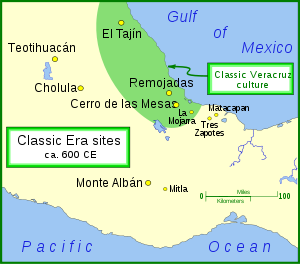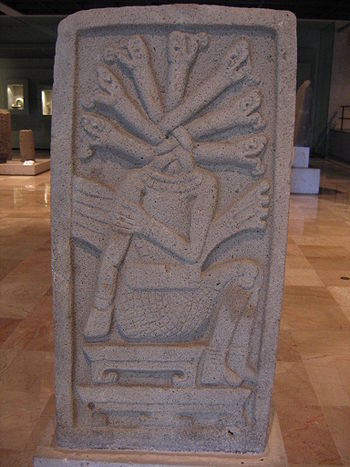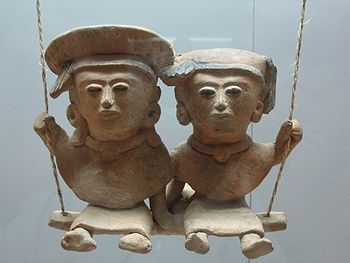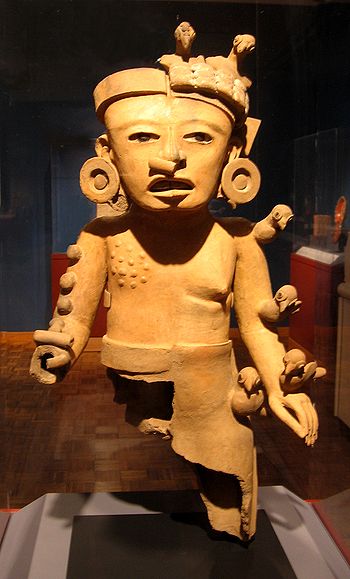
Classic Veracruz culture
Encyclopedia


.jpg)
_2.jpg)



Veracruz
Veracruz, formally Veracruz de Ignacio de la Llave officially Estado Libre y Soberano de Veracruz de Ignacio de la Llave , is one of the 31 states that, along with the Federal District, comprise the 32 federative entities of Mexico. It is divided in 212 municipalities and its capital city is...
, a culture that existed from roughly 100 to 1000 CE, or during the Classic era
Mesoamerican chronology
Mesoamerican chronology divides the history of pre-Columbian Mesoamerica into several periods: the Paleo-Indian , the Archaic , the Preclassic , the Classic , and the Postclassic...
.
El Tajin
El Tajín
El Tajín is a pre-Columbian archeological site and was the site of one of the largest and most important cities of the Classic era of Mesoamerica. The city flourished from 600 to 1200 C.E. and during this time numerous temples, palaces, Mesoamerican ballcourts and pyramids were built...
was the major center of Classic Veracruz culture; other notable settlements include Higueras
Higueras
Higueras is a municipality in the comarca of Alto Palancia, Castellón, Valencia, Spain....
, Zapotal, Cerro de las Mesas
Cerro de las Mesas
Cerro de las Mesas, meaning "hill of the altars" in Spanish, is an archaeological site in the Mexican state of Veracruz, in the Mixtequilla area of the Papaloapan River basin...
, Nopiloa, and Remojadas
Remojadas
Remojadas is a name applied to a culture, an archaeological site, as well as an artistic style that flourished on Mexico's Veracruz Gulf Coast from perhaps 100 BCE to 800 CE. The Remojadas culture is considered part of the larger Classic Veracruz culture. Further research into the Remojadas...
, the latter two important ceramics centers. The culture spanned the Gulf Coast
Gulf Coast of Mexico
The Gulf Coast of Mexico stretches along the Gulf of Mexico from the border with the United states at Matamoros, Tamaulipas all the way to the tip of the Yucatán Peninsula at Cancún. It includes the coastal regions along the Bay of Campeche. Major cities include Veracruz, Tampico, and...
between the Pánuco River
Pánuco River
The Pánuco River is a river in Mexico that flows from the River Moctezuma in the Valley of Mexico to the Gulf of Mexico.At its source, it serves as a channel for water-drainage for Mexico City. From there, it becomes the state border between Hidalgo and Querétaro as it moves towards San Luis...
on the north and the Papaloapan River
Papaloapan River
The Papaloapan River is one of the main rivers of the Mexican state of Veracruz. Its name is derived from the Nahuatl papalotl and apan ....
on the south.
Characteristics
The major theme of Classic Veracruz art is human sacrificeHuman sacrifice
Human sacrifice is the act of killing one or more human beings as part of a religious ritual . Its typology closely parallels the various practices of ritual slaughter of animals and of religious sacrifice in general. Human sacrifice has been practised in various cultures throughout history...
, particularly in context of the Mesoamerican ballgame
Mesoamerican ballgame
The Mesoamerican ballgame or Tlatchtli in Náhuatl was a sport with ritual associations played since 1,000 B.C. by the pre-Columbian peoples of Ancient Mexico and Central America...
. This art is rendered with extensive and convoluted banded scrolls that can be seen both on monumental architecture and on portable art, including ceramics and even carved bones. At least one researcher has suggested that the heads and other features formed by the scrolls are a Classic Veracruz form of pictographic writing. This scrollwork may have grown out of similar styles found in Chiapa de Corzo
Chiapa de Corzo (Mesoamerican site)
Chiapa de Corzo is an archaeological site of pre-Columbian Mesoamerica, located in the Central Depression of Chiapas of present-day Mexico. It rose to prominence during the Middle Formative period, becoming a regional center or capital that controlled trade along the Grijalva River. By then, its...
and Kaminaljuyu
Kaminaljuyu
Kaminaljuyu is a Pre-Columbian site of the Maya civilization that was primarily occupied from 1500 BC to AD 1200. Kaminaljuyu has been described as one of the greatest of all archaeological sites in the New World by Michael Coe, although its remains today - a few mounds only - are far less...
.
In addition to the scrollwork, the architecture is known for its ornate ornamentation, such as that seen on the Pyramid of Niches at El Tajin. This ornamentation produces dramatic contrasts of light and shadow, what art historian George Kubler
George Kubler
George Alexander Kubler was an American art historian and among the foremost scholars on the art of Pre-Columbian America and Ibero-American Art....
called a "bold chiaroscuro
Chiaroscuro
Chiaroscuro in art is "an Italian term which literally means 'light-dark'. In paintings the description refers to clear tonal contrasts which are often used to suggest the volume and modelling of the subjects depicted"....
".
While Classic Veracruz culture shows influences from Teotihuacan
Teotihuacan
Teotihuacan – also written Teotihuacán, with a Spanish orthographic accent on the last syllable – is an enormous archaeological site in the Basin of Mexico, just 30 miles northeast of Mexico City, containing some of the largest pyramidal structures built in the pre-Columbian Americas...
and the Maya
Maya civilization
The Maya is a Mesoamerican civilization, noted for the only known fully developed written language of the pre-Columbian Americas, as well as for its art, architecture, and mathematical and astronomical systems. Initially established during the Pre-Classic period The Maya is a Mesoamerican...
, neither of these cultures are its direct antecedents. Instead, the seeds of this culture seems to have come at least in part from the Epi-Olmec culture
Epi-Olmec culture
The Epi-Olmec culture was a cultural area in the central region of the present-day Mexican state of Veracruz, concentrated in the Papaloapan River basin, a culture that existed during the Late Formative period, from roughly 300 BCE to roughly 250 CE. Epi-Olmec was a successor culture to the Olmec,...
centers, such as Cerro de las Mesas
Cerro de las Mesas
Cerro de las Mesas, meaning "hill of the altars" in Spanish, is an archaeological site in the Mexican state of Veracruz, in the Mixtequilla area of the Papaloapan River basin...
and La Mojarra
La Mojarra
La Mojarra is an archaeological site in the Mexican state of Veracruz, located not far from the Gulf Coast at a bend in the Acula River. It was continually occupied from the late Formative period until perhaps as late as 1000 CE....
.
The Classic Veracruz culture is sometimes wrongly associated with the Totonac
Totonac
The Totonac people resided in the eastern coastal and mountainous regions of Mexico at the time of the Spanish arrival in 1519. Today they reside in the states of Veracruz, Puebla, and Hidalgo. They are one of the possible builders of the Pre-Columbian city of El Tajín, and further maintained...
s, who were occupying this territory at the time of the Spanish Conquest of Mexico
Spanish conquest of Mexico
The Spanish conquest of the Aztec Empire was one of the most important campaigns in the Spanish colonization of the Americas. The invasion began in February 1519 and was acclaimed victorious on August 13, 1521, by a coalition army of Spanish conquistadors and Tlaxcalan warriors led by Hernán Cortés...
. However, there is little or no evidence that the Totonacs were the originators of the Classic era culture.
Social structure
Burials, monumental sculpture, relief carvings, and the distribution of architecture within the regional centers all point to a stratification of Classic Veracruz society, including the presence of an eliteElite
Elite refers to an exceptional or privileged group that wields considerable power within its sphere of influence...
rank as well as craft specialization. Elite hereditary rulers held sway over these small- to medium-sized regional centers, none over 2000 km², maintaining their rule through political and religious control of far-flung trade networks and legitimizing it through typical Mesoamerican rites such as bloodletting, human sacrifice, warfare, and use of exotic goods. Much or most of the population, however, lived in isolated homesteads, hamlets, or villages.
Like the Epi-Olmec
Epi-Olmec culture
The Epi-Olmec culture was a cultural area in the central region of the present-day Mexican state of Veracruz, concentrated in the Papaloapan River basin, a culture that existed during the Late Formative period, from roughly 300 BCE to roughly 250 CE. Epi-Olmec was a successor culture to the Olmec,...
and Olmec
Olmec
The Olmec were the first major Pre-Columbian civilization in Mexico. They lived in the tropical lowlands of south-central Mexico, in the modern-day states of Veracruz and Tabasco....
cultures before it, Classic Veracruz culture was based on swidden, or slash-and-burn, agriculture, with maize an important component of the diet, supplemented with domestic dog, wild deer and other mammals, and fish and shellfish. Cotton was also an important crop.
The Classic Veracruz culture venerated many common Mesoamerican deities, in particular a death god (very prominent at El Tajin and often associated with the Aztec
Aztec
The Aztec people were certain ethnic groups of central Mexico, particularly those groups who spoke the Nahuatl language and who dominated large parts of Mesoamerica in the 14th, 15th and 16th centuries, a period referred to as the late post-classic period in Mesoamerican chronology.Aztec is the...
Mictlantecuhtli
Mictlantecuhtli
Mictlantecuhtli , in Aztec mythology, was a god of the dead and the king of Mictlan , the lowest and northernmost section of the underworld. He was one of the principal gods of the Aztecs and was the most prominent of several gods and goddesses of death and the underworld...
) and an earth monster (likely inherited from the Olmec
Olmec
The Olmec were the first major Pre-Columbian civilization in Mexico. They lived in the tropical lowlands of south-central Mexico, in the modern-day states of Veracruz and Tabasco....
culture).
Mesoamerican ballgame
The Classic Veracruz culture was seemingly obsessed with the ballgame. Every cultural center had at least one ballcourt, while up to 18 ballcourts have been found at El Tajin. It was during Late Classic here in north-central Veracruz that the ballgame reached its height.The ballgame rituals appear throughout Classic Veracruz monumental art. The walls of largest ballcourt, the South Ballcourt at El Tajin are lined with carved murals showing human sacrifice in the context of the ballgame (see photo above). The culmination of these murals is a tableau showing the rain god, who pierces his penis (an act of bloodletting) to replenish a vat of the alcoholic, ritual drink pulque
Pulque
Pulque, or octli, is a milk-colored, somewhat viscous alcoholic beverage made from the fermented sap of the maguey plant, and is a traditional native beverage of Mexico. The drink’s history extends far back into the Mesoamerican period, when it was considered sacred, and its use was limited to...
, the apparent desired end result of the ballgame ritual sacrifice.
A defining characteristic of the Classic Veracruz culture is the presence of stone ballgame gear: yokes, hachas, and palmas. Yokes are U-shaped stones worn about the waist of a ballplayer, while the hachas and palmas sit upon the yoke. Archaeologists generally suppose that the stone yokes are ritual versions of leather, cotton, and/or wood yokes, although no such perishable artifacts have yet been unearthed. While the yokes and hachas have been found from Teotihuacan to Guatemala, the palmas seem peculiar to what is today northern Veracruz.
Ceramics
Until the early 1950s, the Classic Veracruz ceramics were few, little understood, and generally without provenanceProvenance
Provenance, from the French provenir, "to come from", refers to the chronology of the ownership or location of an historical object. The term was originally mostly used for works of art, but is now used in similar senses in a wide range of fields, including science and computing...
. Since then, the recovery of thousands of figurines and pottery pieces from sites such as Remojadas
Remojadas
Remojadas is a name applied to a culture, an archaeological site, as well as an artistic style that flourished on Mexico's Veracruz Gulf Coast from perhaps 100 BCE to 800 CE. The Remojadas culture is considered part of the larger Classic Veracruz culture. Further research into the Remojadas...
, Los Cerros, Dicha Tuerta, and Tenenexpan, some initially by looters, has expanded our understanding and filled many museum shelves. Artist and art historian Miguel Covarrubias
Miguel Covarrubias
José Miguel Covarrubias Duclaud was a Mexican painter and caricaturist, ethnologist and art historian among other interests. In 1924 at the age of 19 he moved to New York City armed with a grant from the Mexican government, tremendous talent, but very little English speaking skill. Luckily,...
described Classic Veracruz ceramics as "powerful and expressive, endowed with a charm and sensibility unprecedented in other, more formal cultures".
Remojadas
Remojadas
Remojadas is a name applied to a culture, an archaeological site, as well as an artistic style that flourished on Mexico's Veracruz Gulf Coast from perhaps 100 BCE to 800 CE. The Remojadas culture is considered part of the larger Classic Veracruz culture. Further research into the Remojadas...
style figurines, perhaps the most easily recognizable, are usually hand-modeled, and often adorned with appliqué
Applique
In its broadest sense, an appliqué is a smaller ornament or device applied to another surface. In the context of ceramics, for example, an appliqué is a separate piece of clay added to the primary work, generally for the purpose of decoration...
s. Of particular note are the Sonrientes (smiling faces) figurines, with triangular-shaped heads and outstretched arms. Nopiloa figurines are usually less ornate, without appliqués, and often molded.
The Classic Veracruz culture produced some of the few wheeled Mesoamerican figurines and is also noted for the use of bitumen for highlighting.
External links
- A Nopiloa-style figurine of a woman in ceremonial dress, 700 - 900 CE.
- A Nopiloa-style ballplayer figurine, 700 - 1000 CE. Note the yoke worn about the waist.
- A broad collection of Classic Veracruz ceramics from the Logan Museum at Beloit CollegeBeloit CollegeBeloit College is a liberal arts college in Beloit, Wisconsin, USA. It is a member of the Associated Colleges of the Midwest, and has an enrollment of roughly 1,300 undergraduate students. Beloit is the oldest continuously operated college in Wisconsin, and has the oldest building of any college...
.

